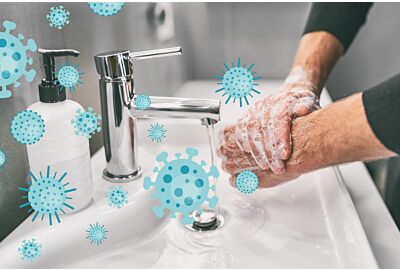Washing hands, as we have known since before yesterday, makes our daily lives safer and supports our health. But in addition to our willingness to use soap and water regularly, the choice of equipment we use is also crucial. What do we mean by this? Simply put, not all soap dispensers are the same. And we don't always leave the sink with cleaner hands, even if we think we do after an extensive wash.
In particular, refillable soap dispensers of the simplest kind pose proven public health risks!
Not all soap dispensers are the same
When we wash our hands, we expect them to be clean afterwards. Unfortunately, however, there is a widely used type of hand soap dispenser that has the potential to load our hands with more germs than before we washed them. At GOJO, we refer to this type of soap dispenser as "refillable bulk packs". Instead of a sealed refill container inside the dispenser that is replaced when empty, this type of dispenser has a simple opening into which the user pours soap. We've probably all seen these dispensers before - in public toilets at rest stops, restaurants and even schools. There are many different designs, but they all carry the same risks.
Proven risks of refillable soap dispensers
These types of refillable dispensers have been around for decades. GOJO began investigating the quality and public health risks in the early 2000s and sponsored independent studies on these systems. Unfortunately, these dispensers are still in use because they are often sold as a cheaper option and there is a lack of awareness of the risks associated with these dispensers. These dispenser systems have a fundamental design flaw - they use the same container and nozzle for the life of the dispenser. This, along with the mixing of different soap products, leads to risks to public health and safety.
What are the health and safety risks?
1. Contamination
Every time the lid is opened for refilling, germs can enter the storage container (where the product is), which can lead to bacterial growth in the dispenser.
Contamination is introduced by, for example:
- unclean hands of toilet staff (e.g. if they have just cleaned the toilets).
- airborne germs (such as faecal bacteria or those from coughing or sneezing)
- Foreign objects (such as flies, dust and plastic parts)
- Diluting soap with water
2. Soaps are mixed
The practice of refilling soap, often with different brands, can affect the performance of the soap and lead to unknown reactions of the preservatives in the soap, which sometimes cancel each other out. It also often leads to phase separation, as two different soap products, even of the same colour, are usually not mixable.
3. Formation of biofilms
Leaving soap in the same dispenser for a long period of time without cleaning it regularly and thoroughly increases the risk of biofilm formation. A biofilm forms when groups of bacteria adhere to surfaces in a moist environment. They are very difficult to wash off or kill and have been researched for decades.1 As biofilm forms on the inside of the dispenser, it leads to bacterial contamination of any new soap added to the dispenser. Once dispensers are contaminated with biofilm, even cleaning and soaking in bleach has proven ineffective, as biofilms are very resistant.
Sealed refills eliminate the risks
The solution to the above problems is sealed refills that simply snap into the existing dispenser.
This eliminates the risk of contamination and keeps the dispenser system clean. Why? Quite simply, with a sealed system, the soap fill is never opened and the soap is therefore not exposed to the environment or possible contamination.
Other advantages of the sealed refills:
- The change is very simple and takes only a few seconds.
- Foam soap refills have a longer shelf life than lotion soaps and need to be refilled less frequently.
- Lockable dispensers and protected refills prevent theft and tampering.
- Newer systems have large viewing windows or exposed refills so that maintenance can see at a glance when a refill is needed.
GOJO encourages its customers to switch from refillable soap dispensers to SANITARY SEALED™ dispensing systems. We have been offering GOJO SANITARY SEALED™ refills since 1983 and offer a complete range of liquid soaps and antiseptic dispensing systems with SANITARY SEALED™ refills.
1 Montana State University Center for Biofilm Engineering, “Biofilm basics: Section 1."













